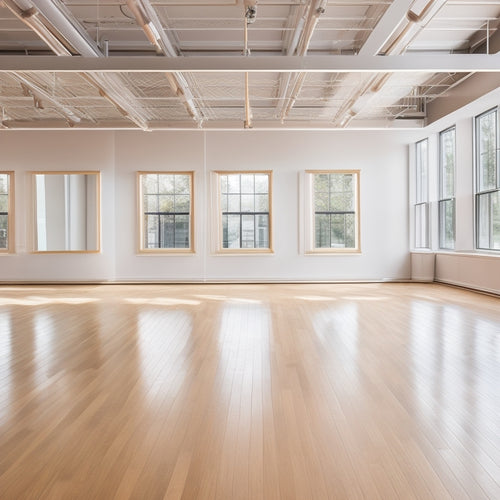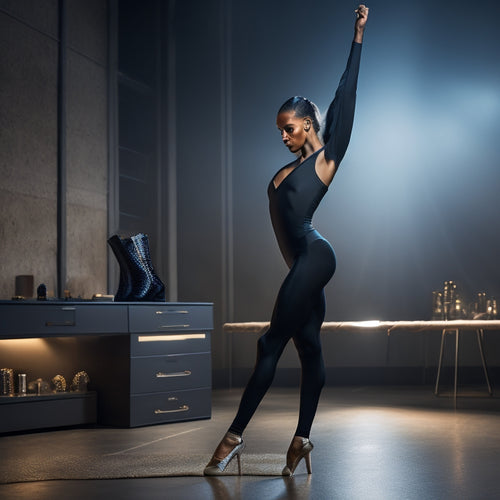
How High Is a Ballet Bar Supposed to Be?
Share
You're aiming to place your ballet bar at a height that promotes proper alignment and technique, ideally between 32 and 42 inches above the floor. This standard range guarantees a neutral spine and core engagement, helping you focus on your movements without discomfort or strain. However, you may need to adjust the height based on your own height, age, and the type of class you're taking. Explore the factors that affect ideal bar height and learn how to measure and adjust it for a more effective and safe workout, leading you to refined techniques and improved overall performance.
Key Takeaways
• Ballet bars should be set at a standardized height between 32-42 inches above the floor to ensure proper alignment and technique.
• The ideal bar height is influenced by the dancer's height and age, with taller dancers requiring a higher bar and shorter dancers a lower bar.
• Measure from the floor to the elbow crease to determine the ideal bar height alignment for each individual.
• Adjustable bars allow for customizable height options to cater to unique needs and body types, promoting comfortable workouts and injury prevention.
• Studios typically adhere to a height range of 32-42 inches above the floor to promote a neutral spine and core engagement.
Understanding Ballet Bar Height Standards
You'll typically find that ballet bars are set at a standardized height to guarantee proper alignment and technique, with most studios adhering to a range of 32-42 inches (81-107 cm) above the floor.
This uniformity stems from a rich barre history, where early 20th-century ballet masters emphasized the importance of proper alignment and posture. Today, safety regulations dictate that bars be installed at a height that allows dancers to maintain a neutral spine and engage their core, reducing the risk of injury.
By adhering to these standards, dancers can focus on mastering intricate movements and expressions, unencumbered by discomfort or strain.
With a correctly positioned bar, you'll be free to explore the full range of ballet movements, unhindered by physical constraints.
Factors Affecting Ideal Bar Height
As you consider the ideal ballet bar height, you'll need to take into account several key factors.
Your height and age, for instance, will influence the bar's best position, as will the type of studio or class you're in.
These factors will interact in complex ways, so understanding their individual and collective impacts on your ballet practice is crucial.
Dancer's Height and Age
Dancer's height and age significantly impact the ideal bar height, with taller dancers generally requiring a higher bar to maintain proper alignment and shorter dancers requiring a lower bar to avoid overstretching.
As you grow, your ideal bar height will change. During growth spurts, your body type may shift, affecting your alignment and bar height needs. For example, if you're experiencing a growth spurt, you may need a higher bar to accommodate your increasing height.
Conversely, if you're petite, a lower bar will help you maintain proper alignment without straining. By considering your height and age, you can find a bar height that allows you to move freely and comfortably, promoting proper technique and injury prevention.
Studio and Class Type
In ballet studios, the type of class or rehearsal being conducted greatly influences the ideal bar height. Classes focused on technique and alignment often require a different bar height than those focused on expression and movement.
You'll notice that home studios or private lessons often have more flexibility in bar height, as they cater to individual needs. In contrast, group classes may require a more standardized bar height to accommodate multiple students.
Consider the class type: are you leading a beginner's class or an advanced pointe class? This will help you determine the optimal bar height for your students. By adjusting the bar height according to your studio and class type, you can create a safe and effective learning environment.
Measuring and Adjusting Bar Height
Measure the distance from the floor to the inside of your elbow crease to determine the ideal bar height, which should align with the top of your shoulder or be slightly above. This guarantees proper alignment and comfort during exercises. To adjust the bar height, use barrel clamps to secure the bar to the floor anchors. Make adjustments in small increments, checking the height after each change.
| Bar Height | User Height Range | Adjustment Needed |
|---|---|---|
| 36-40 inches | 5'2'-5'6' | Lower bar for shorter users |
| 40-44 inches | 5'7'-6'1' | Ideal height for average users |
| 44-48 inches | 6'2'-6'6' | Raise bar for taller users |
| 32-36 inches | 4'11'-5'1' | Lower bar for younger users |
| Custom | Custom | Consult with instructor or adjust as needed |
Benefits of Adjustable Ballet Bars
As you consider the benefits of adjustable ballet bars, you'll find that customizable height options allow you to tailor the bar to your specific needs, ensuring a comfortable and effective workout.
This feature is particularly useful for studios that cater to dancers of varying heights and skill levels.
Additionally, adjustable ballet bars often boast a space-saving design, making them an ideal choice for studios with limited floor space.
Customizable Height Options
You can optimize your ballet practice with adjustable ballet bars that cater to your unique needs, allowing you to customize the height to suit your body type, skill level, and exercise requirements. This level of customization provides the freedom to tailor your practice to your personal preference, ensuring a more effective and comfortable workout.
Additionally, teachers can exercise discretion when setting the bar height, accommodating students with varying needs and abilities. By adjusting the height, you can target specific muscle groups, improve your technique, and reduce the risk of injury.
With customizable height options, you're empowered to take control of your ballet practice and achieve your goals.
Space-Saving Design
Flexibility in studio design is maximized with adjustable ballet bars, which effortlessly slide into compact configurations to conserve valuable floor space. You'll appreciate the adaptability of these bars, which can be easily adjusted to accommodate different class sizes and exercises.
Compact designs enable efficient layouts, allowing you to make the most of your studio's square footage. Imagine having the freedom to reconfigure your space as needed, without sacrificing functionality. Adjustable ballet bars provide the ultimate in versatility, ensuring your studio remains clutter-free and organized.
Common Mistakes in Bar Placement
Incorrectly positioned ballet bars hinder proper alignment, forcing dancers to compromise their posture and technique. You may assume that placing the bar at a comfortable height is sufficient, but this assumption can lead to poor alignment and inefficient movement.
A common mistake is positioning the bar too high or too low, which can put unnecessary strain on your back, shoulders, or legs. This incorrect placement can also reinforce poor posture habits, making it difficult to correct your technique over time.
Be aware of your bar placement, and avoid making assumptions about what feels comfortable. Instead, focus on maintaining proper alignment and engaging your core to support your movements. By doing so, you'll be able to execute movements with more precision and control.
Best Practices for Barre Work
To execute effective barre work, position yourself correctly at the bar, with your feet shoulder-width apart and your arms relaxed by your sides, allowing you to maintain ideal posture and generate power from your core.
As you begin, prioritize barre etiquette by respecting your fellow dancers' space and avoiding distractions. Select music that complements your tempo and movement style, ensuring a fluid and focused practice.
Keep your movements deliberate and controlled, engaging your core and maintaining proper alignment. Focus on executing each exercise with precision, rather than rushing through the sequence.
Frequently Asked Questions
Can Ballet Bars Be Used by Dancers With Disabilities or Injuries?
"As you reimagine ballet's Renaissance-era roots, remember that modern ballet bars can be adapted for all, thanks to accessible equipment and inclusive practices, empowering dancers with disabilities or injuries to move freely and unapologetically."
How Often Should Ballet Bars Be Cleaned and Disinfected?
You should establish sanitizing schedules for your ballet bars, incorporating daily wipes with a gentle disinfectant to prevent the spread of germs, ensuring a healthy dance environment that promotes freedom of movement.
Are There Different Types of Ballet Bars for Different Dance Styles?
You'll find ballet bars tailored to specific dance styles, offering Contemporary adjustments and Modern adaptations to accommodate diverse techniques, allowing you to move freely and express yourself without restriction.
Can Ballet Bars Be Used for Exercises Other Than Ballet?
'Practice makes perfect' - and you're wondering if ballet bars are only for ballet? Think again! You can use them for exercises that target core strength and functional fitness, accessing a world of freedom in your fitness journey.
Are Ballet Bars Required in All Dance Studios and Schools?
You'll find that ballet bars aren't required in all dance studios and schools, as studio requirements and education standards vary, but they're often considered essential for proper ballet training and technique development.
Related Posts
-

Best Studio Mirrors for a Professional Dance Space
Choosing the best mirrors for your professional dance space can enhance your practice. High-quality glass mirrors pro...
-

5 Dance Performance Apparel Must-Haves for a Flawless Routine
You rely on your dancewear to deliver a flawless performance, and that's exactly what it should do. Your dance perfor...
-

Issuu's Dynamic Flipbook Creation: Engage & Share
Issuu's dynamic flipbook creation platform revolutionizes digital content creation, offering an intuitive and seamles...


